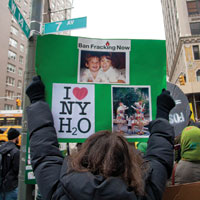New Worries for New Yorkers
 Some of the most densely populated areas in America—including the Tribeca, Chelsea and Meatpacking neighborhoods of lower Manhattan—are in the proposed path of a massive new natural gas pipeline.
Some of the most densely populated areas in America—including the Tribeca, Chelsea and Meatpacking neighborhoods of lower Manhattan—are in the proposed path of a massive new natural gas pipeline.
The New Jersey-New York Expansion Project, known as “The Spectra Pipeline” is a 30-inch-diameter pipeline that will transport up to 800 million cubic feet per day of natural gas from hydraulic fracturing or “fracking” sites in nearby states through New Jersey cities, including Bayonne and Jersey City, across the Hudson River, entering Manhattan at the southwest corner of the Gansevoort Peninsula at the West Side Highway near West 14th Street. From there, the gas will be transported into existing Con Edison underground lines. It’s all part of New York City’s plan to transfer as much of its public energy sourcing to natural gas as possible.
The two zip codes which sit adjacent to the pipeline’s entrance, 10014 and 10011, comprise an area barely over one square mile yet have a combined population of approximately 80,000 people. This includes roughly 5,000 children under the age of 14, according to the U.S. Census Bureau. There are 12 public schools in these two small neighborhoods. One, Public School 3, lies approximately 2,500 feet from the pipeline’s entrance. There are numerous restaurants and a number of playgrounds within walking distance of the pipeline entrance.
If you expand the radius of proximity to the pipeline entrance, the stakes are even higher. The four closest zip codes—10013, 10011, 10001, and 10014—together encompass the popular lower west side neighborhoods of Tribeca, the West Village, Chelsea and the Meatpacking District. Almost 10,000 children under the age of 10 live in these four zip codes.

Pipelines are prone to accidents. In fact, the list of such accidents is so long that the Wikipedia listing on them is divided into sections by decade.
Spectra Energy, the company behind the pipeline, has a history of major accidents and safety violations, including a 2004 series of explosions at a Spectra gas facility in Moss Bluff, Texas, that leaked six billion cubic feet of gas into the air and forced residents within three miles to evacuate. In June 2012, a ruptured Spectra pipeline caused a flash fire in rural Western Canada.
And pipeline accidents in other cities have given New Yorkers plenty of reason to worry. In September 2010 a high pressure gas pipeline exploded in San Bruno, a San Francisco suburb, destroying 38 homes and damaging 120 more. Eight people died and many were injured. The same pipeline had recorded 26 leaks between 1951 and 2009.
Clare Donohue, a leader of saneenergyproject.org, one of several organizations now mounting legal challenges against the pipeline, notes that the San Bruno pipeline was similar in pressure and size to the proposed Spectra pipeline in New York City. “This is a 30-inch gas pipeline,” she says, “and it’s coming in with the force of a fire hose.”
Jim Hall, former chairman of the National Transportation Safety Board under President Clinton, put it this way: “All of these underground pipelines are potential bombs.”

Meanwhile, Spectra’s corporate website advises residents living near its pipelines to exercise certain precautions, advising them to “take care in tilling and plowing not to damage the pipeline,” and noting that “burning anything within the pipeline right-of-way could impact the integrity of the pipeline facilities.”
But the Spectra website offers no precautionary suggestions for the most extensive underground subway system in the world; a massive underground municipal water system; or one of the largest underground electricity delivery systems—all of which will be in close proximity to the new gas pipeline
While the entire project has been virtually absent from the media, initial construction for the pipeline began in August 2012. Quickly, opposition mounted and protesters were arrested in September after they temporarily stopped construction by sitting directly in the path of a back hoe
But the public backlash against fracking in New York had begun. In August, 2,500 protesters marched in Albany, New York, delivering a Pledge of Resistance against fracking to New York Governor Andrew Cuomo, which calls for civil disobedience to stop fracking and fracking-related activities in New York.
At the time of this writing, several lawsuits are in process to try to delay or stop the Spectra pipeline. Pending the results of the lawsuits, however, this 30-inch diameter pipeline by a company with a history of safety violations and accidents will be pumping gas through the most densely populated county in the U.S. as early as November of 2013.

